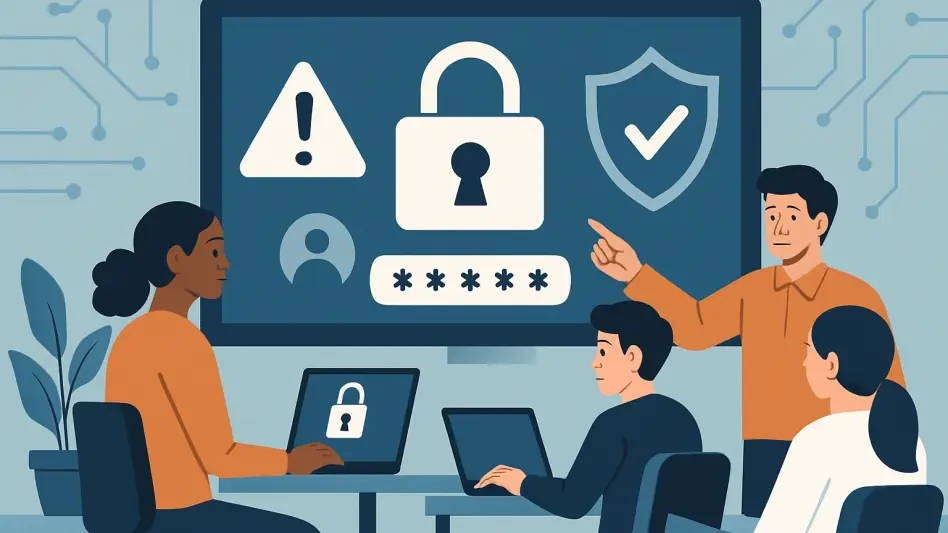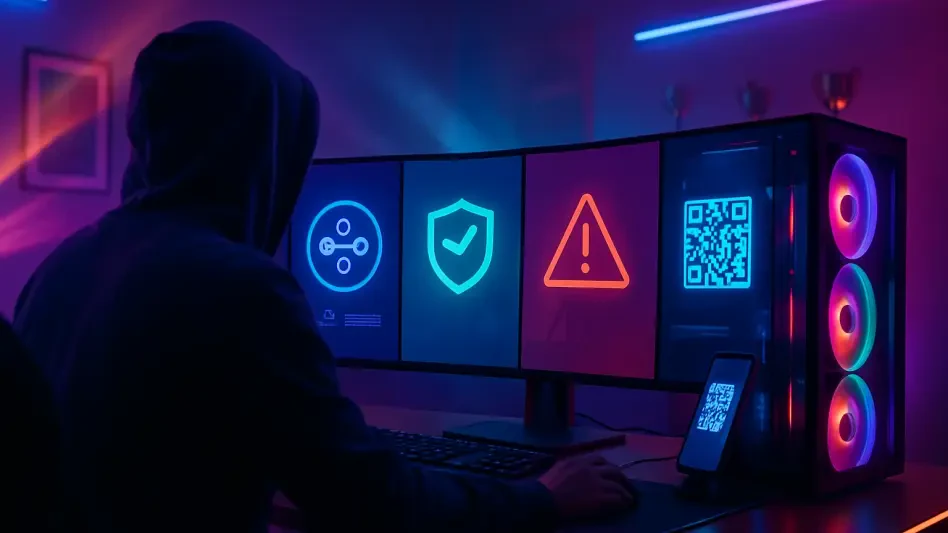In an era where digital threats loom larger than ever, the human element remains the most vulnerable link in an organization’s cybersecurity chain, and a single misguided click by an employee can unravel even the most advanced security systems. This reality, exposing sensitive data to malicious actors, highlights the urgent need for organizations to prioritize security awareness as a fundamental pillar of their defense strategy. By cultivating a culture where every team member understands their role in safeguarding digital assets, businesses can transform potential weaknesses into powerful lines of defense. The journey to achieving this involves deliberate steps, from leadership commitment to continuous education, ensuring that security becomes second nature to all employees. This article explores actionable strategies that organizations can adopt to build and sustain a robust security awareness framework, turning their workforce into proactive protectors against evolving cyber risks.
1. Leadership as the Foundation of Security Culture
Building a strong security awareness culture begins with unwavering commitment from the top. When leaders actively champion cybersecurity, it sets a powerful precedent for the entire organization. Executives must not only endorse security policies but also visibly adhere to them, demonstrating that no one is above the rules. This means participating in training sessions alongside staff, allocating sufficient budgets for security initiatives, and regularly addressing the importance of vigilance in company-wide communications. Such actions send a clear signal that cybersecurity is a priority, not an afterthought. By embedding security into the organization’s core values, leadership ensures that employees at all levels recognize its significance. This top-down approach helps foster an environment where security is not seen as a burden but as a shared responsibility, encouraging everyone to stay alert and informed about potential threats.
Beyond setting an example, leadership must also ensure accountability across the organization. This involves establishing clear expectations for compliance with security protocols and integrating these standards into performance evaluations. Leaders should work closely with IT and HR teams to develop policies that are both practical and enforceable, ensuring that employees understand the consequences of negligence. Regular updates on emerging threats, shared through internal channels, can further reinforce the message that cybersecurity is an ongoing priority. By consistently emphasizing the role of every individual in protecting the organization, leaders can cultivate a mindset of vigilance that permeates all departments. This proactive stance not only mitigates risks but also builds trust, as employees see that their leaders are invested in creating a secure workplace. Over time, this dedication from the top transforms security awareness into a fundamental aspect of the organizational culture.
2. Crafting Effective and Engaging Training Programs
Training is a cornerstone of any successful security awareness initiative, but it must be designed to resonate with employees. Generic, one-size-fits-all sessions often fail to capture attention or address specific risks relevant to different roles. Instead, training content should be customized—for instance, teaching sales teams to spot phishing emails disguised as client inquiries, while guiding developers on secure coding practices. Short, frequent modules delivered throughout the year prove more effective than lengthy annual seminars, as they keep information fresh and relevant. Incorporating interactive elements, such as quizzes or simulated phishing exercises, can further engage participants and reinforce learning. By tailoring programs to address real-world scenarios and offering flexible formats like videos or mobile-friendly courses, organizations can ensure that training is accessible and impactful for all staff members.
Moreover, the effectiveness of training hinges on its ability to evolve with the threat landscape. Cyber risks are not static, and neither should training programs be. Regularly updating content to reflect the latest attack methods, such as ransomware or social engineering tactics, ensures that employees remain equipped to handle new challenges. Gathering feedback after each session can provide valuable insights into what works and what needs improvement, allowing for continuous refinement. Organizations should also consider gamification techniques, rewarding employees for completing modules or identifying mock threats, to make learning more enjoyable. By fostering an environment where education is ongoing and engaging, businesses can empower their workforce to act as the first line of defense. This dynamic approach to training not only builds knowledge but also instills confidence, enabling employees to navigate digital risks with greater awareness and caution.
3. Ensuring Consistent Communication and Reinforcement
Clear and consistent communication plays a vital role in embedding security awareness into daily operations. Employees need regular reminders of best practices and updates on emerging threats to stay vigilant. Utilizing multiple channels, such as email updates, internal newsletters, and team meetings, ensures that key messages reach everyone, regardless of their role or location. These communications should be concise yet informative, highlighting real-world examples of cyber incidents and their impact on businesses. Explaining how individual actions can either protect or jeopardize the organization helps employees grasp the personal relevance of security protocols. By maintaining an open dialogue about cybersecurity, organizations can demystify complex topics and encourage staff to ask questions or report suspicious activity without fear of repercussions, fostering a collaborative approach to risk management.
Beyond regular updates, communication strategies should focus on building a sense of shared responsibility. Tailoring messages to different departments can make them more relatable—for example, emphasizing data protection for HR teams handling sensitive employee information. Visual aids like infographics or quick-reference guides can simplify complex policies, making them easier to remember and apply. Additionally, creating a dedicated internal portal or hotline for security concerns provides employees with a direct resource for guidance. Celebrating successes, such as recognizing teams that excel in identifying phishing attempts, can further reinforce positive behavior. This consistent reinforcement helps integrate security into the fabric of everyday work, ensuring that it remains top of mind. Over time, these efforts build a culture where employees instinctively prioritize cybersecurity, reducing the likelihood of costly mistakes and enhancing overall resilience against digital threats.
4. Embedding Security in Employee Lifecycles
Integrating security awareness into every stage of an employee’s journey with the organization is essential for sustained protection. From the moment a new hire joins, comprehensive training should be a non-negotiable part of onboarding, covering key policies, password management, and how to recognize threats. This early education sets the tone, establishing security as a core expectation rather than an optional task. Providing new employees with practical tools, such as secure access credentials and guides for safe online behavior, equips them to contribute to the organization’s defenses from day one. Equally important is ensuring that temporary staff or contractors receive the same level of training, as they often handle sensitive data yet may not be as familiar with internal protocols. By making security a foundational element of the onboarding process, organizations lay the groundwork for a vigilant workforce that understands its role in safeguarding digital assets.
The focus on security must also extend to the offboarding process to prevent vulnerabilities when employees depart. Immediate revocation of access privileges, secure return of company devices, and thorough exit interviews to address data handling are critical steps in this phase. Organizations should ensure that departing staff are reminded of confidentiality agreements and the importance of protecting sensitive information even after leaving. Implementing automated systems to disable accounts and track asset returns can streamline this process, minimizing the risk of oversight. Additionally, conducting post-exit audits to verify that no unauthorized access remains helps close potential loopholes. By embedding security protocols into both onboarding and offboarding, organizations create a seamless framework that protects their systems throughout an employee’s tenure and beyond. This holistic approach ensures that security remains a priority at every touchpoint, reducing risks associated with transitions.
5. Driving Continuous Improvement Through Feedback
A robust security awareness program is never static; it requires ongoing evaluation and adaptation to remain effective. Organizations must regularly assess the impact of their initiatives by analyzing metrics such as incident rates, training completion percentages, and response times to simulated threats. These data points provide a clear picture of where gaps exist and which areas need reinforcement. Equally important is soliciting direct feedback from employees through surveys or focus groups to understand their experiences with training and communication efforts. This input can reveal whether content is engaging, relevant, or overly complex, allowing for targeted improvements. By treating security awareness as a dynamic process rather than a one-off task, businesses can stay ahead of evolving cyber risks and ensure their programs remain aligned with current challenges.
Furthermore, fostering an environment where employees feel comfortable sharing concerns or suggestions enhances the effectiveness of these programs. Encouraging open dialogue about security issues, such as reporting near-miss incidents without fear of blame, builds trust and promotes a collaborative mindset. Organizations should act on feedback promptly, whether by simplifying policies or addressing specific vulnerabilities highlighted by staff. Regularly benchmarking against industry standards or peer organizations can also provide valuable insights into best practices worth adopting. This commitment to continuous improvement not only strengthens the security framework but also demonstrates to employees that their input matters. By consistently refining strategies based on real-world data and employee perspectives, businesses can create a resilient culture of awareness that adapts to new threats and maintains a high level of readiness across all levels.
Final Reflections: Strengthening Defenses Through Commitment
Looking back, the journey to building strong security awareness within organizations has demanded persistent effort and strategic focus. Leadership played a pivotal role by setting the tone, while tailored training programs equipped employees with essential knowledge. Consistent communication kept the importance of cybersecurity at the forefront, and integrating protocols into employee lifecycles ensured no gaps were left unchecked. Continuous improvement, driven by feedback and metrics, allowed for necessary adjustments along the way. Moving forward, organizations should deepen their investment in innovative training tools and technologies to keep pace with emerging threats. Exploring partnerships with cybersecurity experts can offer fresh perspectives and resources. By maintaining this dedication and adapting to the ever-changing digital landscape, businesses can empower their workforce to remain the strongest shield against cyber risks, securing a safer future for all.








